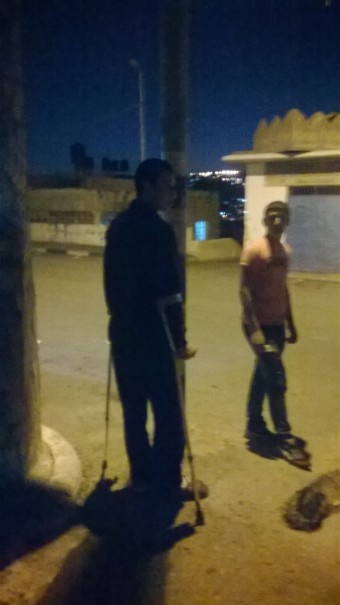When leaving work last week, I stepped into the dark winter evening to see figures gathering, followed by a white cloud. They were returning from a demonstration, faces covered, taking a new position to wait and watch. In the distance army vehicles drove away, along the separation wall from where the protest had begun. No one knew whether the army was actually leaving, or if they were planning an ambush, to arrest the boys as if criminals. By then the white cloud had reached me. Chilli-like tear gas filled my nose and throat and in an instant my eyes were streaming. Suddenly, I was a part of it. The teenagers around me, rehearsed in this event, quickly presented tissues and raw, cut onion. Deep breaths over the flesh of an onion serves as an effective antidote to the chemical irritant. Next, a school boy started a fire, explaining that smoke will fight the gas. One protester was gripping a catapult, while another was hanging back, watching. The boy further back was balancing on crutches, the bullet wound in his leg a reminder of what could happen. At the front of the crowd a figure whose identity was concealed by a heavy gas mask, stood armed with a camera, ready to shoot. When nothing further happened, they concluded that this time the soldiers really had left.


But the soldiers would be back. At 1am yesterday, two brothers were
arrested from their home. One of them, aged 20, was shot in the head
with a rubber bullet when throwing stones last month. Those who helped
him were shot in the process, but eventually managed to get him to a
hospital. He had made a recovery and returned home. Then yesterday
morning, he and his brother were taken from their beds and locked away
for ”security reasons”. A spy balloon has now appeared in the sky. The
floating camera is a visual reminder that here in the big prison,
nothing goes unseen.
Most people reading this are probably aware of the awful incident that recently happened in Jerusalem. A Palestinian man drove his car into a crowd, killing a baby. The story hit the headlines across the UK, deeming the man a terrorist. The Israeli police shot him to death at the scene.
What did not reach British Media, was that a few days before, an Israeli settler in Ramallah drove his car into 2 Palestinian children, killing a 5 year old girl and badly injuring another. The police have turned a blind eye to this incident and the Isreali driver has not been identified.
The family of the man shot dead by the police in Jerusalem has been denied the right to a funeral. Israel possesses his body and has set conditions for it’s burial: 1) it must take place in the middle of the night, 2) the body must go straight to the grave, 3) only 20 people can be present. If these conditions are not met, the body will go to the ‘numbers graveyard’ and be anonymous. On Sunday, his loved ones gathered on the outskirts of Jerusalem to mark the end of his life. A close eye was kept on this event. On the news I saw them surrounded by soldiers and security lights, and out of the window, heard helicopters overhead.
The above incidents have fueled Palestinian resistance. These are people who continue to have their cultural and religious identities squashed and whose children are being killed. They are people who, when responding to violence with violence, are labeled terrorists.

No comments:
Post a Comment